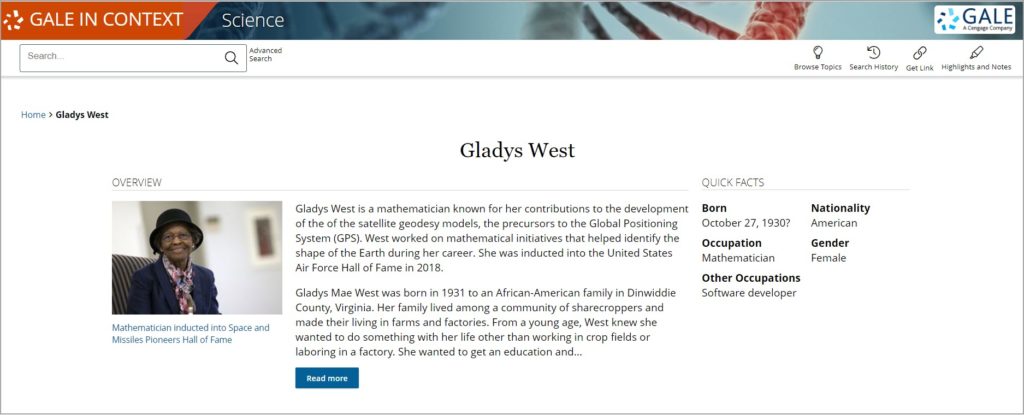| By Carol Brennan |
It’s likely that Gladys West (1930–) helped you arrive at your last destination safely and on time, thanks to one of the true marvels of our age, the Global Positioning System (GPS). Known for decades in her field as the mathematician who created the first geodetic model of the Earth, West wrote the mathematical equations that permit satellites to provide continuously updated and accurate location data for any object in the world. For Black History Month 2022, Gale In Context: Science provides intriguing biographical profiles of West, along with other unsung Black Americans who pursued careers in the fields of science, technology, engineering, and mathematics (STEM).
Born in Sutherland, Virginia, West graduated as valedictorian at her segregated high school in 1948, and entered Virginia State College, a historically Black college, where she majored in mathematics. Abandoning low-paying work as a schoolteacher, she returned to Virginia State to earn her master’s degree, and in 1956 landed a prized job as a civilian employee of the U.S. military at the Naval Surface Warfare Center in Virginia. She was one of four Black Americans working at the Dahlgren Division; one of the others was Ira West, her future husband.

Gladys West was one of the mathematicians who wrote the programs run by enormous mainframe computers at the Dahlgren Division, at its Naval Weapons Laboratory in Dahlgren, Virginia. Her work involved writing the equations used to program room-sized computers into triangulating the distance between observational satellites and the Earth’s surface. The rapid technological gains made during the 1970s and ‘80s in computer-processing power and aerospace hardware enabled the launch of the U.S. Department of Defense’s GPS in the 1980s. In 1996 the U.S. government made GPS technology available for private-sector companies, and over the next decade, GPS devices became a popular consumer electronics product, installed first as stand-alone navigational devices on automotive dashboards and then incorporated into the automobile manufacturing process in many makes and models.
West’s chief contribution to this remarkable technology was writing the equations that allowed for variations in altitude, tides, and other variables when satellites were directed to pinpoint an exact location on the Earth’s surface. This is the satellite geodesy model, and her 1984 achievement allows for precise measurement and mapping of the surface of the Earth from space. In the first wave of media stories trumpeting this new technology in the mid-1980s, GPS was hailed as the replacement for the humble compass, which has been in continuous usage in the West since the late 1100s. West’s skill set in devising oceanography measurements ultimately enabled searchers to find the wreck of the HMS Titanic in 1985.
In articles celebrating her pioneering work, West professed that she had a knack for problem-solving when writing equations. She retired in 1998, after 42 years with the U.S. Navy’s Dahlgren Division facility, and in 2018 was inducted into the Space and Missiles Pioneers Hall of Fame of the U.S. Air Force. A brief update she sent to her sisters of the historic Black sorority Alpha Kappa Alpha about her career resulted in an abundance of news articles paying tribute to her status as one of the “hidden figures” involved in the U.S. space race.
For Black History Month 2022, users of Gale In Context: Science can precisely pinpoint a portal of content on Gladys West, one of the many unsung Black Americans whose contributions in the fields of science, technology, engineering, and mathematics have positively impacted millions of lives.
Read the previous week’s Black History Month contributions here.

About the Author
Carol Brennan has been writing biographical entries for Cengage/Gale since 1993. If she’s not writing, she is either at yoga or walking her dachshund. Carol consumes an alarming volume of podcasts and audiobooks weekly.

